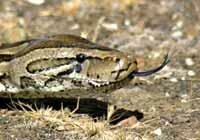 |
 |
|

Not likely to happen ...
Snake bites
 |
Most hikes have had sufficient sightings of snakes, their tracks and cast of skins to be aware of their existence.
Snakes are highly successful predators that are well adapted to their chosen environments and have an important role in controlling small rodents and frogs. They are masters of disguise and deception and, contrary to popular belief, do not generally possess an attitude. Their perceived aggressiveness is more likely to be a defensive behaviour designed to protect themselves or their territory. The fastest recorded snake is the black mamba that has been measured at 14kph (that is a leisurely 25 seconds per 100m) so you may be able to outrun it even in hiking boots and carrying a pack. Their speed of strike is much more rapid and, as they strike at movement, it is preferable to stand stock still so they can’t see you. After a short time they will back off and then so can you.
Of the 165 species in Southern Africa, only about 10% possess venom that is considered dangerous to humans. The following table illustrates the types of venom produced, their symptoms and typical species:
|
Neurotoxic venom
|
Cytotoxic venom
|
Haemotoxic venom
|
|
Effects the nervous system
|
Effects tissue
|
Effects the blood system
|
|
Symptoms: blurring of vision, drooping eyelids, slurred speech, difficulty in swallowing, respiratory paralysis. Potentially fatal:
|
Symptoms: Extensive local tissue damage and destruction, discolouration, blistering and spreading of inflammation to the whole limb.
|
Symptoms: Destruction of blood cells, internal bleeding, skin discolouration. Potentially fatal unless treated with transfusion and antivenom.
|
|
Cobras
Mambas
Berg Adder
Yellow Bellied Sea Snake
|
Adders
Spitting Cobras
|
Boomslang
Vine Snake
|
What do you do if you are unfortunate to come second in a close encounter with a snake?
Foremost you must remain calm. There is no point in chasing around trying to catch the snake as you will both become over excited, the symptoms will reveal the species soon enough and you may end up coming second anyway.
To deal with venom from a spitting cobra (which only needs action if it enters the eyes of an open cut) simply wash out with copious amounts of ay bland liquid.
To deal with a bite in which venom is injected, the individual should be kept at rest to decrease the rate at which venom is absorbed into the bloodstream. A pad should be placed over the wound and a crepe bandage wrapped firmly (but not tightly enough o stop circulation) around as much of the limb as possible. If you do not have a crepe bandage, improvise using socks, a T shirt or other clothing. Splints can assist in immobilizing the limb. Although it looks good in cowboy movies, there is no point in cutting the wound and trying to suck out the venom. Seek help and watch the individual for signs of weakness or breathing difficulty. Apply artificial respiration if necessary. Administration of antivenom is best left to those trained to do so.
How do you find (or avoid) snakes?
Look under rocks and dead trees, into crannies and on to rocky ledges. Most snakes will sense you some distance away and will move out of your path. But beware of the puff adder that remains still, often basking on a grassy path, relying on its camouflage for protection. It will bite you if you stand on it (wouldn’t you do the same?). In the Magaliesberg, there are many more snakes than you think. Look for puff adders and rinkhals on grassy southern slopes and the Mozambique spitting cobra on open savannha and north facing rocky slopes. But wait, there is more: the horned adder, night adder, boomslang, twig snake and snouted cobra (aka the Egyptian cobra) are also venomous residents along with many other more benign species.



 |
 |
 |



